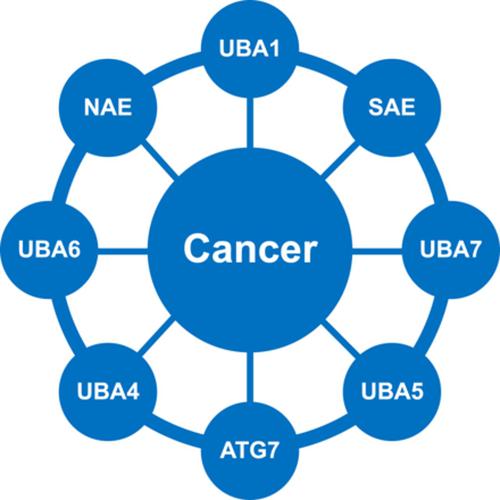当前位置:
X-MOL 学术
›
Pharmacol. Rev.
›
论文详情
Our official English website, www.x-mol.net, welcomes your
feedback! (Note: you will need to create a separate account there.)
E1 Enzymes as Therapeutic Targets in Cancer
Pharmacological Reviews ( IF 19.3 ) Pub Date : 2021-01-01 , DOI: 10.1124/pharmrev.120.000053 Samir H Barghout 1 , Aaron D Schimmer 2
Pharmacological Reviews ( IF 19.3 ) Pub Date : 2021-01-01 , DOI: 10.1124/pharmrev.120.000053 Samir H Barghout 1 , Aaron D Schimmer 2
Affiliation

|
Post-translational modifications of cellular substrates with ubiquitin and ubiquitin-like proteins (UBLs), including ubiquitin, SUMOs, and neural precursor cell–expressed developmentally downregulated protein 8, play a central role in regulating many aspects of cell biology. The UBL conjugation cascade is initiated by a family of ATP-dependent enzymes termed E1 activating enzymes and executed by the downstream E2-conjugating enzymes and E3 ligases. Despite their druggability and their key position at the apex of the cascade, pharmacologic modulation of E1s with potent and selective drugs has remained elusive until 2009. Among the eight E1 enzymes identified so far, those initiating ubiquitylation (UBA1), SUMOylation (SAE), and neddylation (NAE) are the most characterized and are implicated in various aspects of cancer biology. To date, over 40 inhibitors have been reported to target UBA1, SAE, and NAE, including the NAE inhibitor pevonedistat, evaluated in more than 30 clinical trials. In this Review, we discuss E1 enzymes, the rationale for their therapeutic targeting in cancer, and their different inhibitors, with emphasis on the pharmacologic properties of adenosine sulfamates and their unique mechanism of action, termed substrate-assisted inhibition. Moreover, we highlight other less-characterized E1s—UBA6, UBA7, UBA4, UBA5, and autophagy-related protein 7—and the opportunities for targeting these enzymes in cancer.
中文翻译:

E1 酶作为癌症治疗靶点
具有泛素和泛素样蛋白 (UBL) 的细胞底物的翻译后修饰,包括泛素、SUMO 和神经前体细胞表达的发育下调蛋白 8,在调节细胞生物学的许多方面发挥核心作用。UBL 结合级联由称为 E1 激活酶的 ATP 依赖性酶家族启动,并由下游 E2 结合酶和 E3 连接酶执行。尽管 E1 具有成药性并且在级联的顶端处于关键地位,但直到 2009 年,E1 的药理学调节仍然难以捉摸,直到 2009 年为止。和 neddylation (NAE) 是最具特征的,并且涉及癌症生物学的各个方面。迄今为止,据报道,有超过 40 种抑制剂针对 UBA1、SAE 和 NAE,包括 NAE 抑制剂 Pevonedistat,在 30 多项临床试验中进行了评估。在这篇综述中,我们讨论了 E1 酶、它们在癌症中的治疗靶向的基本原理及其不同的抑制剂,重点介绍了氨基磺酸腺苷的药理特性及其独特的作用机制,称为底物辅助抑制。此外,我们强调了其他不太明确的 E1——UBA6、UBA7、UBA4、UBA5 和自噬相关蛋白 7——以及在癌症中靶向这些酶的机会。及其不同的抑制剂,重点介绍氨基磺酸腺苷的药理特性及其独特的作用机制,称为底物辅助抑制。此外,我们强调了其他不太明确的 E1——UBA6、UBA7、UBA4、UBA5 和自噬相关蛋白 7——以及在癌症中靶向这些酶的机会。及其不同的抑制剂,重点介绍氨基磺酸腺苷的药理特性及其独特的作用机制,称为底物辅助抑制。此外,我们强调了其他不太明确的 E1——UBA6、UBA7、UBA4、UBA5 和自噬相关蛋白 7——以及在癌症中靶向这些酶的机会。
更新日期:2020-11-12
中文翻译:

E1 酶作为癌症治疗靶点
具有泛素和泛素样蛋白 (UBL) 的细胞底物的翻译后修饰,包括泛素、SUMO 和神经前体细胞表达的发育下调蛋白 8,在调节细胞生物学的许多方面发挥核心作用。UBL 结合级联由称为 E1 激活酶的 ATP 依赖性酶家族启动,并由下游 E2 结合酶和 E3 连接酶执行。尽管 E1 具有成药性并且在级联的顶端处于关键地位,但直到 2009 年,E1 的药理学调节仍然难以捉摸,直到 2009 年为止。和 neddylation (NAE) 是最具特征的,并且涉及癌症生物学的各个方面。迄今为止,据报道,有超过 40 种抑制剂针对 UBA1、SAE 和 NAE,包括 NAE 抑制剂 Pevonedistat,在 30 多项临床试验中进行了评估。在这篇综述中,我们讨论了 E1 酶、它们在癌症中的治疗靶向的基本原理及其不同的抑制剂,重点介绍了氨基磺酸腺苷的药理特性及其独特的作用机制,称为底物辅助抑制。此外,我们强调了其他不太明确的 E1——UBA6、UBA7、UBA4、UBA5 和自噬相关蛋白 7——以及在癌症中靶向这些酶的机会。及其不同的抑制剂,重点介绍氨基磺酸腺苷的药理特性及其独特的作用机制,称为底物辅助抑制。此外,我们强调了其他不太明确的 E1——UBA6、UBA7、UBA4、UBA5 和自噬相关蛋白 7——以及在癌症中靶向这些酶的机会。及其不同的抑制剂,重点介绍氨基磺酸腺苷的药理特性及其独特的作用机制,称为底物辅助抑制。此外,我们强调了其他不太明确的 E1——UBA6、UBA7、UBA4、UBA5 和自噬相关蛋白 7——以及在癌症中靶向这些酶的机会。











































 京公网安备 11010802027423号
京公网安备 11010802027423号